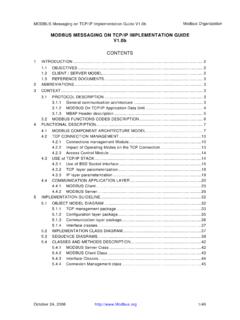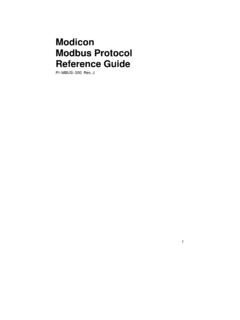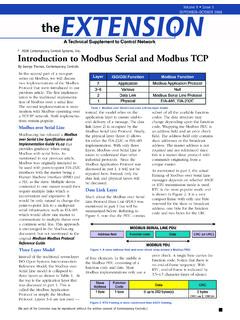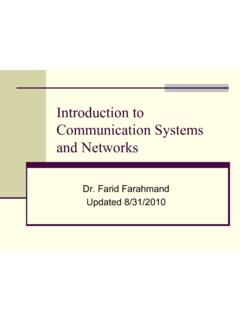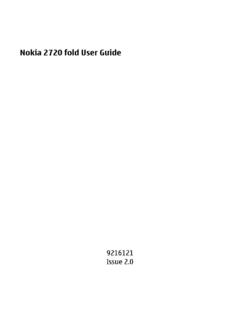Transcription of MODBUS/TCP Security
1 MB-TCP- Security -v21_2018-07-24 1 MODBUS/TCP Security Protocol Specification MODBUS is a registered trademark of Schneider Electric USA, Inc., used under license by Modbus Organization, Inc. MB-TCP- Security -v21_2018-07-24 2 Table of Contents 1 2 1 Conformance Levels .. 3 3 2 Normative Statements .. 3 4 3 References .. 4 5 4 Glossary of Acronyms & Abbreviations .. 5 6 5 Introduction .. 6 7 6 Protocol Overview .. 7 8 Transport Layer Security Introduction .. 7 9 7 Service Definition .. 11 10 8 Protocol Specification .. 11 11 TLS Handshake .. 11 12 Cipher suite 15 13 mbaps Role-Based Client Authorization .. 15 14 9 System Dependencies .. 18 15 10 TLS Requirements.
2 18 16 TLS Version .. 19 17 TLS Cryptography .. 19 18 TLS Key Exchange .. 19 19 TLS Authentication .. 19 20 TLS Encryption .. 20 21 TLS 20 22 TLS PRF .. 20 23 TLS Cryptography Import/Export Policy .. 20 24 TLS Fragmentation .. 21 25 TLS Compression .. 21 26 TLS Session Renegotiation .. 21 27 11 APPENDIX A: mbaps Packet Structure .. 22 28 12 APPENDIX B: Requirements listing .. 24 29 30 List of Figures 31 32 Figure 1 MODBUS/TCP ADU .. 6 33 Figure 2 TLS Communications Protocol Stack .. 7 34 Figure 3 mbap PDU Encapsulated in TLS .. 8 35 Figure 4 MODBUS/TCP Security Concept View .. 9 36 Figure 5 Example Certificate with Role Extension (2161 chars) .. 10 37 Figure 6 TLS Full Handshake Protocol .. 12 38 Figure 7. TLS Resumption .. 14 39 Figure 8 Role-Base Client AuthZ .. 16 40 Figure 9 Example Role Extension .. 16 41 Figure 10 mbaps Role-Based Client AuthZ .. 17 42 Figure 11 TLS Transportation of mbap PDU.
3 22 43 Figure 12 TLS Record Layer Structure .. 22 44 Figure 13 TLS Generic Block Cipher .. 22 45 46 List of Tables 47 48 Table 1 Conformance Levels .. 3 49 Table 2 4 50 Table 3 Glossary of Acronyms & Abbreviations .. 5 51 Table 4 Context Specific Terminology .. 6 52 Table 5 TLS Full Handshake Protocol .. 12 53 Table 6. TLS Resumption handshake .. 14 54 Table 7. Requirements List .. 24 55 56 MB-TCP- Security -v21_2018-07-24 3 1 Conformance Levels 57 58 59 Table 1 Conformance Levels 60 Latest conventions available up-to-now In a standard document, specific notations shall be used to define the significance of each particular requirement. These notations (words) are highlighted by capitalization. As Consistency Rules may have the target to be presented to a standards body in order to become an international standard, the selection of the words "SHALL" and "MUST" should be made according to the rules of the organization that covers the standardization in the affected area of the Specification.
4 Compliance An implementation that satisfies all the MUST / SHALL requirements is said to be unconditionally compliant . One that satisfies all the MUST requirements but not all the SHOULD recommendations is said to be conditionally compliant . An implementation is not compliant if it fails to satisfy one or more of the MUST / SHALL requirements that it implements MUST SHALL REQUIRED All requirements containing the word "MUST / SHALL" are mandatory. The word "MUST / SHALL", or the adjective "REQUIRED", means that the item is an absolute requirement of the implementation. MUST NOT SHALL NOT All requirements containing the word "MUST NOT/ SHALL NOT" are mandatory. The phrase "MUST NOT or the phrase SHALL NOT mean that the item is an absolute prohibition of the specification. SHOULD RECOMMENDED All recommendations containing the word "SHOULD", or the adjective RECOMMENDED are considered desired behaviour. These recommendations should be used as a guideline when choosing between different options to implement functionality.
5 In uncommon circumstances, valid reasons may exist to ignore this item, but the full implication should be understood and the case carefully weighed before choosing a different course. MAY OPTIONAL The word MAY , or the adjective "OPTIONAL", means that this item is truly optional. One implementer may choose to include the item because a particular marketplace requires it or because it enhances the product; another implementer may omit the same item. 61 62 63 2 Normative Statements 64 65 Normative statements in this technical specification are called out explicitly as follows: 66 67 68 69 where " " is replaced by the requirement statement tag number which can be a hierarchical 70 number, or a simple integer, R-1. 71 72 : Normative statement text goes here. MB-TCP- Security -v21_2018-07-24 4 Each statement contains exactly one requirement level keyword ( , "MUST") and one 73 conformance target keyword ( , "Message").
6 Example: The Message MUST be encoded 74 using BER . 75 76 The scope of the tag, , is limited to this technical specification. 77 78 The tag policy is as follows: 79 A tag value is defined when the specification is released to the public. 80 Once defined, the requirement statement associated to a tag MUST NOT change as 81 there is no versioning provided. 82 If a change to a requirement statement is needed, then 83 o The requirement statement requiring change MUST be rendered obsolete and 84 moved to an obsolete tag appendix at the end of the document. 85 o The new requirement statement, with a new tag number, will replace the obsolete 86 requirement statement in the specification. 87 88 3 References 89 Table 2 References 90 Reference Description [62443-3-3] IEC 62443-3-3: System Security requirements and Security levels [62443-4-2] IEC 62443-4-2: Technical Security requirements for IACS components [ ] IEEE Secure Device Identity, 2009-12-22 [EST] IETF RFC 7030, Enrollment over Secure Transport, Oct 2013 [ISASEC] ISAS ecure EDSA-311 Functional Security Assessment (FSA) [MB] Modbus Application Protocol Specification, , 2012-04-26, [MBTCP] Modbus Messaging on TCP/IP Implementation Guide, , 2006-10-24, [PKCS#10] IETF RFC 2986, PKCS#10: Certificate Request Syntax Specification, , Nov 2000 [RFC2315] IETF RFC 2315, PKCS #7: Cryptographic Message Syntax, , Mar 1998 [RFC2986] IETF RFC 2986, PKCS#10: Certificate Request Syntax Specification, , Nov 2000 [RFC3447] IETF RFC 3447, Public-Key Cryptography Standards (PKCS) #1.
7 RSA Cryptography Specifications Version , Feb 2003 [RFC4492] IETF RFC 4492, Elliptic Curve Cryptography (ECC) Cipher Suites for Transport Layer Security (TLS) [RFC5246] IETF RFC 5246, The Transport Layer Security (TLS) Protocol, , Aug 2008 [RFC5272] IETF RFC 5272, Certificate Management over CMS (CMC), Jun 2008 [RFC5280] IETF RFC 5280, Internet Public Key Infrastructure Certificate and Certificate Revocation List (CRL) Profile, May 2008 [RFC5746] IETF RFC 5746, TLS Renegotiation Indication Extension, Feb 2010 [RFC6066] IETF RFC 6066, TLS Extensions: Extension Definitions, Jan 2011 [RFC6176] IETF RFC 6176, Prohibiting Secure Sockets Layer (SSL) Version , Mar 2011 [RFC6347] IETF RFC 6347, Datagram Transport Layer Security Version , Jan 2012 [RFC6960] IETF RFC 6960, Internet PKI Online Certificate Status Protocol - OCSP, Jun 2013 [SCEP] IETF draft SCEP v23, Simple Certificate Enrollment Protocol, draft-nourse-scep-23 [SYSTEM-PKI] System PKI Dependencies companion document [TLS-PARAMS] IANA s Transport Layer parameter type registry.
8 MB-TCP- Security -v21_2018-07-24 5 91 92 93 94 4 Glossary of Acronyms & Abbreviations 95 96 97 Table 3 Glossary of Acronyms & Abbreviations 98 Reference Description ADU Application Data Unit AuthN Authentication AuthZ Authorization CA Certificate Authority CDP CRL Distribution Point CRL Certificate Revocation List DTLS Datagram Transport Layer Security EST Enrollment over Secure Transport HMAC Keyed-hash Message Authentication Code IANA Internet Assigned Numbers Authority ICS Industrial Control System IEC International Electrotechnical Commission ISA International Society of Automation MAC Message Authentication Code mbap Modbus Application Protocol mbaps Modbus Security Application Protocol OID Object Idenitifier standardized by the International Telecommunications Union OCSP Online Certificate Status Protocol PDU Protocol Data Unit PKI Public Key Infrastructure PRF Psuedorandom Function Family RA Registration Authority SCEP Simple Certificate Enrollment Protocol SSL Secure Socket Layer TCP Transport Control Protocol TLS Transport Layer Security 99 100 MB-TCP- Security -v21_2018-07-24 6 5 Introduction 101 102 The MODBUS/TCP protocol is widely deployed in Industrial Control Systems (ICS).
9 The 103 specifications for MODBUS/TCP are found at the web site. The MODBUS/TCP 104 specification defines an Application Data Unit (ADU). This ADU is defined as shown: 105 106 107 Figure 1 MODBUS/TCP ADU 108 The difference between a traditional Modbus Protocol Data Unit (PDU) and the MODBUS/TCP 109 ADU is the addition of the Modbus Application Protocol (mbap) header at the front of the 110 frame. 111 112 In 1996 the MODBUS/TCP protocol, was registered with IANA 113 (Internet Assigned Number Authority) and assigned the 114 system port number 502. In the course of this registration 115 process with IANA the MODBUS/TCP protocol came to be 116 called the mbap protocol because of the mbap header in the 117 MODBUS/TCP ADU. This name, the mbap protocol, persisted 118 and is still used for the port 502 registration with the IANA as 119 mbap/TCP 120 121 The MODBUS/TCP Security protocol is a Security focused 122 variant of the Mobdbus/TCP protocol utilizing Transport 123 Layer Security (TLS).
10 IANA has assigned the MODBUS/TCP 124 Security protocol the system port number 802. 125 has registered the name Modbus Security Application 126 Protocol to the protocol registered at port 802 with IANA as 127 mbap/TLS/TCP 128 129 The selection of TLS as the secure transport protocols is the result of analyzing representative 130 data flows from industry domains in the context of [62443-3-3], [62443-4-2], and [ISASEC] 131 Functional Security requirements. 132 133 Table 4 Context Specific Terminology lists the names used for the mbap communication 134 profiles in different contexts, Communication Profile, , the IANA Registry, and 135 this specification. For reasons of brevity, the remainder of this specification will use mbap and 136 mbaps to refer to MODBUS/TCP and MODBUS/TCP Security respectively. 137 138 Table 4 Context Specific Terminology 139 Communication Profile IANA Registry This specification (for brevity) mbap/TCP MODBUS/TCP Modbus Application Protocol at System Port 502 Mbap mbap/TLS/TCP MODBUS/TCP Security Modbus Security Application Protocol at System Port 802 Mbaps 140 MODBUS/TCP Security Principles MODBUS/TCP Security @ port 802 certificate based identity and authentication with TLS Mutual client/server TLS authentication Authorization using roles transferred via certificates Authorization rules are product specific No changes to mbap MB-TCP- Security -v21_2018-07-24 7 6 Protocol Overview 141 142 In the tradition of Modbus, the mbaps requirements are kept simple allowing vendors to 143 develop additional infrastructure around the protocol and allowing backwards compatibility with 144 legacy devices and fieldbuses.
